Archive:United Kingdom-EU - international trade in goods statistics
Data extracted in March 2021
Planned article update: March 2022
Highlights
EU trade in goods with the United Kingdom, 2010-2020
This article provides a picture of the international trade in goods between the European Union (EU) and the United Kingdom. It analyses the type of goods exchanged between the two economies and the shares of each EU Member State in those exchanges.
This article is part of an online publication providing recent statistics on international trade in goods, covering information on the EU's main partners, main products traded, specific characteristics of trade as well as background information.
Full article
Recent developments, impact of COVID-19
The COVID-19 crisis caused both exports and imports between the EU and the United Kingdom to fall in 2020. Exports reached a minimum of EUR 15.0 billion in April 2020. By December 2020 they had recovered to EUR 27.1 billion. This was well above the EUR 24.7 billion in December 2019, probably due to stockpiling of UK traders in anticipation of border control problems in 2021 related to Brexit. Imports reached a minimum of EUR 10.6 billion in May 2020. By December 2020 they had recovered to EUR 15.8 billion, slightly lower than in December 2019 (EUR 16.2 billion).
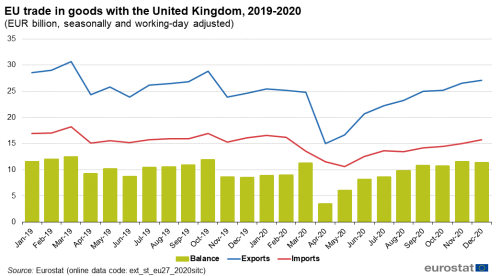
(EUR billion, seasonally and working-day adjusted)
Source: Eurostat (ext_st_eu27_2020sitc)
Figure 2 compares trade with the United Kingdom to trade with other non-EU countries. Between January 2019 and December 2020, exports to the United Kingdom decreased by 5.0 % while exports to other non-EU countries decreased by 2.0 %. Imports from the United Kingdom decreased by 7.0 % while imports from other non-EU countries decreased by 10.1 %. Focusing on the worst months in the pandemic we see that exports to the United Kingdom hit a bottom of 52 % in April 2020 compared to 75 % for other non-EU countries. Imports from the United Kingdom hit their lowest level (62 %) one month later than imports from other non-EU countries which were lowest in April 2020 at 80 % of their January 2019 level.

(Jan 2019 = 100 %, seasonally and working-day adjusted)
Source: Eurostat (ext_st_eu27_2020sitc)
EU and the United Kingdom in world trade in goods
Figure 3a shows the position of the United Kingdom among the largest traders of goods in the world in 2019. The four largest exporters were China (EUR 2 233 billion, 16.1 %), the EU (EUR 2 132 billion, 15.4 %), the United States (EUR 1 468 billion, 10.6 %) and Japan (EUR 630 billion, 4.6 %). The four largest importers were the United States (EUR 2 293 billion, 16.1 %), the EU (EUR 1 940 billion, 13.7 %), China (EUR 1 857 billion, 13.1 %) and Japan (EUR 644 billion, 4.5 %).
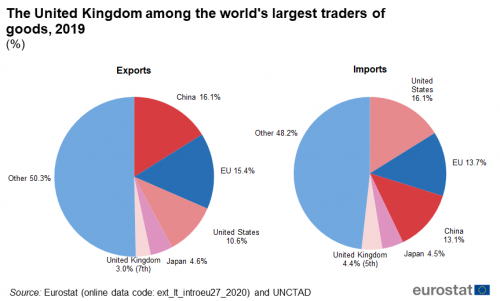
(%)
Source: Eurostat (ext_lt_introeu27_2020) and UNCTAD
Figure 3b has some more details. It shows that the United Kingdom (EUR 420 billion, 3.0 %) was the seventh largest exporter in the world ─ between Hong Kong (EUR 478 billion, 3.5 %) and Mexico (EUR 412 billion, 3.0 %) ─ and the fifth largest importer (EUR 622 billion, 4.4 %) ─ between Japan (EUR 644 billion, 4.5 %) and Hong Kong (EUR 516 billion, 3.6 %).

(EUR billion)
Source: Eurostat (ext_lt_introeu27_2020) and UNCTAD
The imports and exports of goods of the EU and the United Kingdom indexed at 100 in 2009 for the period to 2019 are shown in Figure 4. It also shows the cover ratio (exports / imports) for this period. Exports from the EU were lowest in 2009 (100) and highest in 2019 (180). Imports to the EU were lowest in 2009 (100) and highest in 2019 (163). The cover ratio for the EU was lowest in 2011 (97 %) and highest in 2016 (116 %) and was 110 % in 2019. Exports from the United Kingdom were lowest in 2009 (100) and highest in 2013 (152) and were 132 in 2019. Imports to the United Kingdom were lowest in 2009 (100) and highest in 2019 (134). The cover ratio for the United Kingdom was lowest in 2016 (65 %) and highest in 2013 (82 %) and was 68 % in 2019.

(exports and imports indexed at 100 in 2010, cover ratio in %)
Source: Eurostat (ext_lt_introeu27_2020) and UNCTAD
Exports to the United Kingdom increased but imports decreased between 2010 and 2020.
The position of the United Kingdom among the largest trade partners of the EU in 2020 can be seen in Figure 5a. In 2020, the United Kingdom was the second largest partner for EU exports of goods (14.4 %). It was preceded by the United States (18.3 %) and followed by China (10.5 %), Switzerland (7.4 %) and Russia (4.1 %). It was the third largest partner for EU imports of goods (9.8 %), preceded by China (22.4 %) and the United States (11.8 %) and followed by Switzerland (6.3 %) and Russia (5.6 %).

(% share of extra EU exports/imports)
Source: Eurostat (ext_st_eu27_2020sitc) and Comext DS-018995
Figure 6 shows the exports, imports and trade balance between the EU and the United Kingdom from 2010 to 2020. In 2010, the EU had a trade surplus with the United Kingdom of EUR 61 billion. The trade surplus remained throughout the whole period, reaching EUR 110 billion in 2020. Exports to the United Kingdom increased but imports decreased between 2010 and 2020. EU exports to the United Kingdom were highest in 2017 (EUR 321 billion) and lowest in 2010 (EUR 230 billion). EU imports from the United Kingdom were highest in 2018 (EUR 197 billion) and lowest in 2020 (EUR 167 billion).
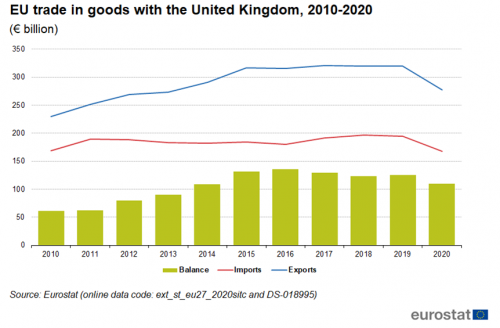
Source: Eurostat (ext_st_eu27_2020sitc) and Comext DS-018995
EU-the United Kingdom trade by type of goods
The breakdown of EU trade with the United Kingdom by SITC groups is shown in Figure 7. The red shades denote the primary products: food & drink, raw materials and energy, while the blue shades show the manufactured goods: chemicals, machinery & vehicles and other manufactured goods. Finally, other goods are shown in green. In 2020, EU exports of manufactured goods (79 %) had a higher share than primary goods (19 %). The most exported manufactured goods were machinery & vehicles (38 %), followed by other manufactured products (25 %) and chemicals (16 %). In 2020, EU imports of manufactured goods (76 %) also had a higher share than primary goods (21 %). The most imported manufactured goods were machinery & vehicles (34 %), followed by other manufactured products (22 %) and chemicals (20 %).

Source: Eurostat (ext_st_eu27_2020sitc) and Comext DS-018995
Figure 8 shows the evolution of EU imports and exports by SITC group since 2010. In 2020, the EU had trade surpluses in machinery & vehicles (EUR 49 billion), other manufactured products (EUR 31 billion), food & drink (EUR 23 billion), chemicals (EUR 11 billion), raw materials (EUR 3 billion) and other products (EUR 3 billion). The EU has a trade deficit in energy (EUR 10 billion).

Source: Eurostat (ext_st_eu27_2020sitc) and Comext DS-018995
EU-the United Kingdom most traded goods
More detail about the goods exchanged between the EU and the United Kingdom is given in Figure 9, showing the 20 most traded goods at SITC-3 level. These top 20 goods covered 35 % of total trade in goods in 2020. Seven belonged to machinery and vehicles, five to chemicals, four to other manufactured products, two each to food and drink and energy. The most traded product group at this level was motor cars and motor vehicles. Another interesting way to look at the data is to investigate the cover ratio (exports / imports) of traded goods, showing the direction of the trade flows between the two economies. These ratios can be found in the right-hand margin of Figure 9. One product (petroleum oils, crude with 1 %) was below 50 %, indicating EU imports from the United States were at least twice as large as EU exports to the United States. Six products were above 200 %, indicating EU exports to the United Kingdom were at least twice as large as EU imports from the United Kingdom. 13 products were between 50 % and 200 %, showing more balanced trade.
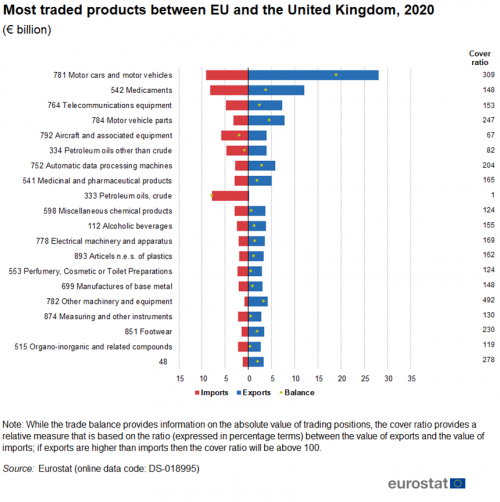
Source: Eurostat DS-018995
Trade with the United Kingdom by Member State
Table 1a shows the imports of goods from the United Kingdom by Member State. The three largest importers from the United Kingdom in the EU were Germany (EUR 37 990 million), Ireland (EUR 23 513 million) and the Netherlands (EUR 22 112 million). Ireland (44.0 %) had the highest share for the United Kingdom in its extra-EU imports.

Source: Eurostat (ext_st_eu27_2020sitc) and Comext DS-018995
Table 1b shows the exports of goods to the United Kingdom by Member State. The three largest exporters to the United Kingdom in the EU were Germany (EUR 66 886 million), the Netherlands (EUR 44 899 million) and Belgium (EUR 28 037 million). Netherlands (22.2 %), Poland (21.8 %) and Belgium (2378.0 %) had the highest share for the United Kingdom in their extra-EU exports.

Source: Eurostat (ext_st_eu27_2020sitc) and Comext DS-018995
The trade in goods balance between the EU Member States and the United Kingdom is shown in Table 1c. It shows that 23 Member States had a trade surplus with the United Kingdom. The largest surplus was held by Germany (EUR 28 896 million), followed by the Netherlands (EUR 22 786 million) and Italy (EUR 14 003 million). There were four Member States that had a trade deficit with the United Kingdom. The largest deficit was held by Ireland (EUR 9 066 million), followed by Cyprus (EUR 440 million) and Malta (EUR 337 million).
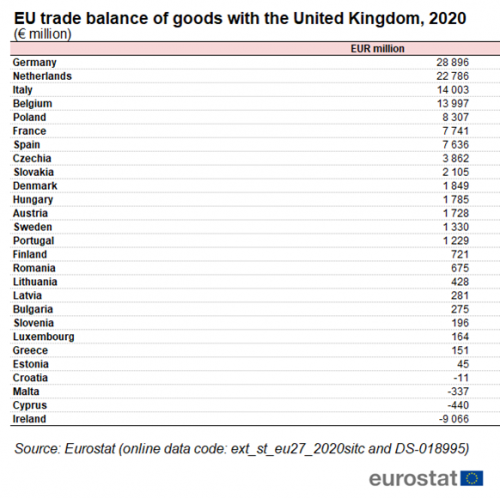
Source: Eurostat (ext_st_eu27_2020sitc) and Comext DS-018995
Source data for tables and graphs
Data sources
EU data is taken from Eurostat's COMEXT database. COMEXT is the reference database for international trade in goods. It provides access not only to both recent and historical data from the EU Member States but also to statistics of a significant number of third countries. International trade aggregated and detailed statistics disseminated via the Eurostat website are compiled from COMEXT data according to a monthly process.
Data are collected by the competent national authorities of the Member States and compiled according to a harmonised methodology established by EU regulations before transmission to Eurostat. For extra-EU trade, the statistical information is mainly provided by the traders on the basis of customs declarations.
EU data are compiled according to Community guidelines and may, therefore, differ from national data published by the Member States. Statistics on extra-EU trade are calculated as the sum of trade of each of the 27 EU Member States with countries outside the EU. In other words, the EU is considered as a single trading entity and trade flows are measured into and out of the area, but not within it.
The United Kingdom is considered as an extra-EU partner country for the EU-27 for the whole period covered by this article. However, the United Kingdom was still part of the internal market until the end of the transitory period (31 December 2020), meaning that data on trade with the United Kingdom are still based on statistical concepts applicable to trade between the EU Member States. Consequently, while imports from any other extra-EU-27 trade partner are grouped by country of origin, the United Kingdom data reflect the country of consignment. In practice this means that the goods imported by the EU-27 from the United Kingdom were physically transported from the United Kingdom but part of these goods could have been of other origin than the United Kingdom. For this reason, data on trade with the United Kingdom are not fully comparable with data on trade with other extra-EU-27 trade partners.
Data for the non-EU-27 countries used in figures 1 to 3 are taken from the UNCTAD database of the United Nations. For the calculation of shares the world trade is defined as the sum of EU trade with non-EU countries (source: Eurostat) plus the international trade of non-EU countries (source: UNCTAD).
Methodology
According to the EU concepts and definitions, extra-EU trade statistics (trade between EU Member States and non-EU countries) do not record exchanges involving goods in transit, placed in a customs warehouse or given temporary admission (for trade fairs, temporary exhibitions, tests, etc.). This is known as ‘special trade’. The partner is the country of final destination of the goods for exports and the country of origin for imports.
Product classification
Information on commodities exported and imported is presented according to the Standard international trade classification (SITC). A full description is available from Eurostat’s classification server RAMON.
Unit of measure
Trade values are expressed in millions or billions (109) of euros. They correspond to the statistical value, i.e. to the amount which would be invoiced in the event of sale or purchase at the national border of the reporting country. It is called a FOB value (free on board) for exports and a CIF value (cost, insurance, freight) for imports.
Context
Trade is an important indicator of Europe’s prosperity and place in the world. The bloc is deeply integrated into global markets both for the products it sources and the exports it sells. The EU trade policy is one of the main pillars of the EU’s relations with the rest of the world.
Because the 27 EU Member States share a single market and a single external border, they also have a single trade policy. EU Member States speak and negotiate collectively, both in the World Trade Organization, where the rules of international trade are agreed and enforced, and with individual trading partners. This common policy enables them to speak with one voice in trade negotiations, maximising their impact in such negotiations. This is even more important in a globalised world in which economies tend to cluster together in regional groups.
The openness of the EU’s trade regime has meant that the EU is the biggest player on the global trading scene and remains a good region to do business with. Thanks to the ease of modern transport and communications, it is now easier to produce, buy and sell goods around the world which gives European companies of every size the potential to trade outside Europe.
Direct access to
- International trade in goods (t_ext_go), see:
- International trade in goods - long-term indicators (t_ext_go_lti)
- International trade in goods - short-term indicators (t_ext_go_sti)
- International trade in goods (ext_go), see:
- International trade in goods - aggregated data (ext_go_agg)
- International trade in goods - long-term indicators (ext_go_lti)
- International trade in goods - short-term indicators (ext_go_sti)
- International trade in goods - detailed data (detail)
- EU trade since 1988 by SITC (DS-018995)
- International trade in goods statistics - background
- International trade in goods (ESMS metadata file — ext_go_esms)
- User guide on European statistics on international trade in goods